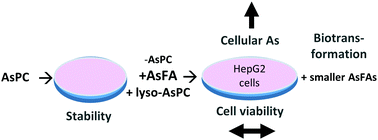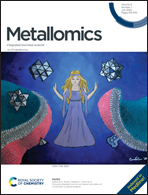Toxicological assessment of arsenic-containing phosphatidylcholines in HepG2 cells†
Abstract
Arsenolipids include a wide range of organic arsenic species that occur naturally in seafood and thereby contribute to human arsenic exposure. Recently arsenic-containing phosphatidylcholines (AsPCs) were identified in caviar, fish, and algae. In this first toxicological assessment of AsPCs, we investigated the stability of both the oxo- and thioxo-form of an AsPC under experimental conditions, and analyzed cell viability, indicators of genotoxicity and biotransformation in human liver cancer cells (HepG2). Precise toxicity data could not be obtained owing to the low solubility in the cell culture medium of the thioxo-form, and the ease of hydrolysis of the oxo-form, and to a lesser degree the thioxo-form. Hydrolysis resulted amongst others in the respective constituent arsenic-containing fatty acid (AsFA). Incubation of the cells with oxo-AsPC resulted in a toxicity similar to that determined for the hydrolysis product oxo-AsFA alone, and there were no indices for genotoxicity. Furthermore, the oxo-AsPC was readily taken up by the cells resulting in high cellular arsenic concentrations (50 μM incubation: 1112 ± 146 μM As cellular), whereas the thioxo-AsPC was substantially less bioavailable (50 μM incubation: 293 ± 115 μM As cellular). Speciation analysis revealed biotransformation of the AsPCs to a series of AsFAs in the culture medium, and, in the case of the oxo-AsPC, to as yet unidentified arsenic species in cell pellets. The results reveal the difficulty of toxicity studies of AsPCs in vitro, indicate that their toxicity might be largely governed by their arsenic fatty acid content and suggest a multifaceted human metabolism of food derived complex arsenolipids.



 Please wait while we load your content...
Please wait while we load your content...